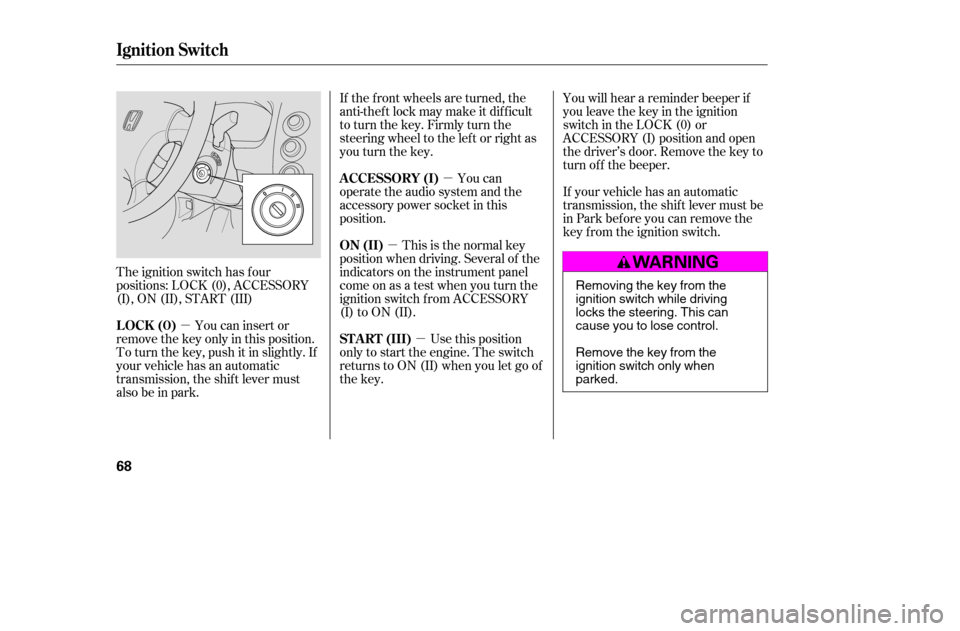Page 61 of 226
Make sure you have securely
locked the steering wheel in place
by trying to move it up and down.
Make any steering wheel adjustment
bef ore you start driving.
Push the lever under the steering
column all the way down.
Move the steering wheel up or
down to the desired position.
Make sure you can see the
instrument panel gauges and
indicators.Push the lever up to lock the
steering wheel in position.
1. 4.
3.
2.
Steering Wheel A djustment
Inst rument s and Cont rols
65
Adjusting the steering wheel
position while driving may
cause you to lose control of the
vehicle and be seriously injured
inacrash.
Adjust the steering wheel only
when the vehicle is stopped.
�����—�����—�����y�
�������������y���
�(���%�������y���������y
Page 64 of 226

�µ
�µ �µ
�µ
The ignition switch has f our
positions: LOCK (0), ACCESSORY
(I), ON (II), START (III) If the f ront wheels are turned, the
anti-thef t lock may make it dif f icult
to turn the key. Firmly turn the
steering wheel to the lef t or right as
you turn the key.
Use this position
only to start the engine. The switch
returns to ON (II) when you let go of
the key.
You can insert or
remove the key only in this position.
To turn the key, push it in slightly. If
your vehicle has an automatic
transmission, the shif t lever must
also be in park. You can
operate the audio system and the
accessory power socket in this
position.
This is the normal key
position when driving. Several of the
indicators on the instrument panel
come on as a test when you turn the
ignition switch f rom ACCESSORY
(I) to ON (II). You will hear a reminder beeper if
you leave the key in the ignition
switch in the LOCK (0) or
ACCESSORY (I) position and open
the driver’s door. Remove the key to
turn of f the beeper.
If your vehicle has an automatic
transmission, the shif t lever must be
in Park bef ore you can remove the
key f rom the ignition switch.
ST A RT (III)
LOCK (0) A CCESSORY (I)
ON (II)
Ignition Switch
68
Removing the key from the
ignition switch while driving
locks the steering. This can
cause you to lose control.
Remove the key from the
ignition switch only whenparked.
�����—�����—�����y�
�������������y���
�(���%�������y�������
�y
Page 77 of 226
The outside mirrors are heated to
remove fog and frost. With the
ignition switch in the ON (II)
position, turn on the heaters by
pressing the button. The indicator in
the button comes on as a reminder.
Press the button again to turn the
heaters off.To apply the parking brake, pull the
lever up f ully. To release it, pull up
slightly, push the button, and lower
the lever. The parking brake
indicator on the instrument panel
should go out when the parking
brake is f ully released (see page ).
55
On Canadian Si models
Power Mirror Heaters Parking Brake
Mirrors, Parking Brake
Inst rument s and Cont rols
81
PARKING BRAKE
LEVER
U.S. : Value Package, LX, EX, Special
Edition
Canada: DX Special Edition, REVERB,
LX, Si PARKING BRAKE LEVER
U.S. : DX, HX
Canada: DX
Driving the vehicle with the parking
brake applied can damage the rear
brakes and axles.
�����—�����—�����y�
�������������y���
�(���%�������y���������y
Page 91 of 226

On models with in-dash CD changerOn models with in-dash CD changer
You can display the sound with
spectroscopic analysis. There are
five modes of display; Peak-Hold,
Normal, Aurora, Level and Off. Each
time you press and release the DISP
button, the mode changes f rom P.
HOLD to NORMAL to AURORA to
LEVEL, then to OFF. You see the
selected mode in the display f or
about 5 seconds as it changes.You can use the instrument panel
brightness control knob to adjust the
illumination of the audio system (see
page ). The audio system
illuminates when the parking lights
are on, even if the radio is turned of f .
You can also select the reduced
brightness in the display when the
parking lights are on. Press and hold
the DISP button for about 5 seconds
until you hear a beep to change the
brightness. Press and hold this
button again f or about 5 seconds
until you hear a beep to return to the
f ull brightness.
63
Playing the Radio
Spect roscopic A nalysis
Display bright ness
A udio System L ighting
96
�����—�����—�����y�
�������������y���
�(���%�������y���������y
Page 112 of 226
If equipped
Cruise control allows you to maintain
asetspeedabove25mph(40km/h)
without keeping your f oot on the
accelerator pedal. It should be used
f or cruising on straight, open
highways. It is not recommended f or
city driving, winding roads, slippery
roads, heavy rain, or bad weather.Accelerate to the desired cruising
speedabove25mph(40km/h).Press and release the SET/decel
buttononthesteeringwheel.The
indicator on the instrument panel
comes on to show the system is
now activated.
Push in the CRUISE button. The
indicator will come on.
1. 2. 3.
CONT INUED
Cruise Control
Using Cruise Control
Features
117
CANCEL BUTTON
RESUME/ accel
BUTTON
SET/decel
BUTTON
CRUISE BUTTON
Improper use of the cruise
control can lead to a crash.
Use the cruise control only
when traveling on open
highways in good weather.
�����—�����—�����y�
������
������y���
�(���%�������y���
�����y
Page 113 of 226

You can decrease the set cruising
speed in any of these ways:To slow down in very small
amounts, tap the SET/decel
button. Each time you do this,
your vehicle slows down about 1
mph (1.6 km/h).
Press and hold the SET/decel
button. Release the button when
you reach the desired speed.
You can increase the set cruising
speed in any of these ways:
Press and hold the RESUME/
accel button. When you reach the
desired cruising speed, release the
button.
Tap the brake or clutch pedal
lightly with your f oot. The
CRUISE CONTROL indicator on
the instrument panel goes out.
When the vehicle slows to the
desired speed, press the SET/
decel button.
Cruise control may not hold the set
speed when you are going up and
down hills. If your speed increases
going down a hill, use the brakes to
slow down. This will cancel cruise
control. To resume the set speed,
press the RESUME/accel button.
The CRUISE CONTROL indicator
on the instrument panel will come
back on.
When climbing a steep hill, the
automatic transmission may
downshif t to hold the set speed.
Push on the accelerator pedal until
you reach the desired cruising
speed, and press the SET/decel
button.
To increase the speed in very
small amounts, tap the RESUME/
accel button. Each time you do
this, your vehicle speeds up about
1 mph (1.6 km/h).
Changing the Set Speed
Cruise Control
118
�����—�����—�����y�
������
������y���
�(���%�������y���
���
�y
Page 116 of 226

Help assure your vehicle’s f uture
reliability and perf ormance by paying
extra attention to how you drive
during the f irst 600 miles (1,000 km).
During this period:Avoid full-throttle starts and rapid
acceleration.
You should also f ollow these
recommendations with an
overhauled or exchanged engine, or
when the brakes are replaced. Avoidhardbrakingforthefirst
200 miles (300 km).
Do not change the oil until the
scheduled maintenance time. Your vehicle is designed to operate
on unleaded gasoline with a pump
octane number of 86 or higher. Use
of a lower octane gasoline can cause
a persistent, heavy metallic rapping
noise that can lead to engine damage.
We recommend using quality
gasoline containing detergent
additives that help prevent fuel
system and engine deposits.
In addition, in order to maintain good
perf ormance, f uel economy, and
emissions control, we strongly
recommend, in areas where it is
available, the use of gasoline that
does NOT contain manganese-based
f uel additives such as MMT.
Use of gasoline with these additives
may adversely af f ect perf ormance,
and cause the malfunction indicator
lamp on your instrument panel to
come on. If this happens, contact your authorized dealer f or service.
Some gasoline today is blended with
oxygenates such as ethanol or
MTBE. Your vehicle is designed to
operate on oxygenated gasoline
containing up to 10 percent ethanol
by volume and up to 15 percent
MTBE by volume. Do not use
gasoline containing methanol.
If you notice any undesirable
operating symptoms, try another
service station or switch to another
brand of gasoline.
For f urther important f uel-related
inf ormation, please ref er to your
.
Break-in Period Fuel Recommendation
Quick Start Guide
Break-in Period, Fuel Recommendation
122
�����—�����—�����y�
�������������y���
�(���%�������y���
�����y
Page 127 of 226
Fasten your seat belt. Check that
your passengers have f astened
their seat belts (see page ).
Make sure the doors are securely
closed and locked.
Check the steering wheel
adjustment (see page ).
Check the adjustment of the
inside and outside mirrors (see
page ).
Check that any items you may be
carrying are stored properly or
f astened down securely.
Check the seat adjustment (see
page ).
Make sure all windows, mirrors,
and outside lights are clean and
unobstructed. Remove f rost, snow,
or ice.
Youshoulddothefollowingchecks
and adjustments bef ore you drive
your vehicle.
Check that the hood is f ully closed.
Check that the trunk is f ully
closed.
Visually check the tires. If a tire
looks low, use a gauge to check its
pressure. When you start the engine, check
the gauges and indicators in the
instrument panel (see page ).
1. 2. 14
3. 4. 5. 6. 7. 8. 9.
11.
10.
80
73
65 51
Preparing to Drive
134
�����—�����—�����y�
�������������y���
�(���%�������y���
�����y